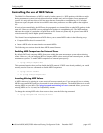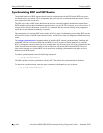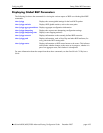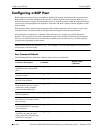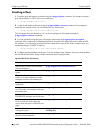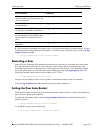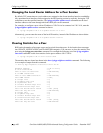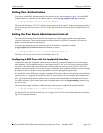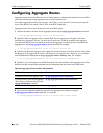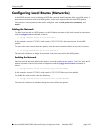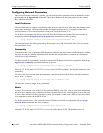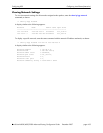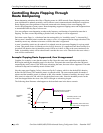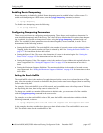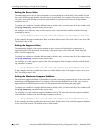
Configuring BGP Configuring a BGP Peer
OmniSwitch 6800/6850/9000 Advanced Routing Configuration Guide December 2007 page 4-31
Setting Peer Authentication
You can set which MD5 authentication key this router will use when contacting a peer. To set the MD5
authentication key, enter the peer IP address and key with the ip bgp neighbor md5 key command:
-> ip bgp neighbor 123.24.5.6 md5 key keyname
The peer with IP address 123.24.5.6 will be sent messages using “keyname” as the encryption password. If
this is not the password set on peer 123.24.5.6, then the local router will not be able to communicate with
this peer.
Setting the Peer Route Advertisement Interval
The route advertisement interval specifies the frequency at which routes external to the autonomous
system are advertised. These advertisements are also referred to as UPDATE messages. This interval
applies to advertisements to external peers.
To set the advertisement interval, enter the number of seconds in conjunction with the
ip bgp neighbor advertisement-interval command, as shown:
-> ip bgp neighbor 123.24.5.6 advertisement-interval 50
The interval is now set to 50 seconds. The default value is 30.
Configuring a BGP Peer with the Loopback0 Interface
Loopback0 is the name assigned to an IP interface to identify a consistent address for network manage-
ment purposes. The Loopback0 interface is not bound to any VLAN, so it will always remain operation-
ally active. This differs from other IP interfaces in that if there are no active ports in the VLAN, all IP
interface associated with that VLAN are not active. In addition, the Loopback0 interface provides a unique
IP address for the switch that is easily identifiable to network management applications.
It is possible to create BGP peers using the Loopback0 IP interface address of the peering router and bind-
ing the source (i.e., outgoing IP interface for the TCP connection) to its own configured Loopback0 inter-
face. The Loopback0 IP interface address can be used for both Internal and External BGP peer sessions.
For EBGP sessions, if the External peer router is multiple hops away, the ebgp-multihop parameter may
need to be used.
The following example configures a BGP peering session using a Loopback0 IP interface address:
-> ip bgp neighbor 2.2.2.2 update-source Loopback0
See the OmniSwitch 6800/6850/9000 Network Configuration Guide for more information about configur-
ing an IP Loopback0 interface.



